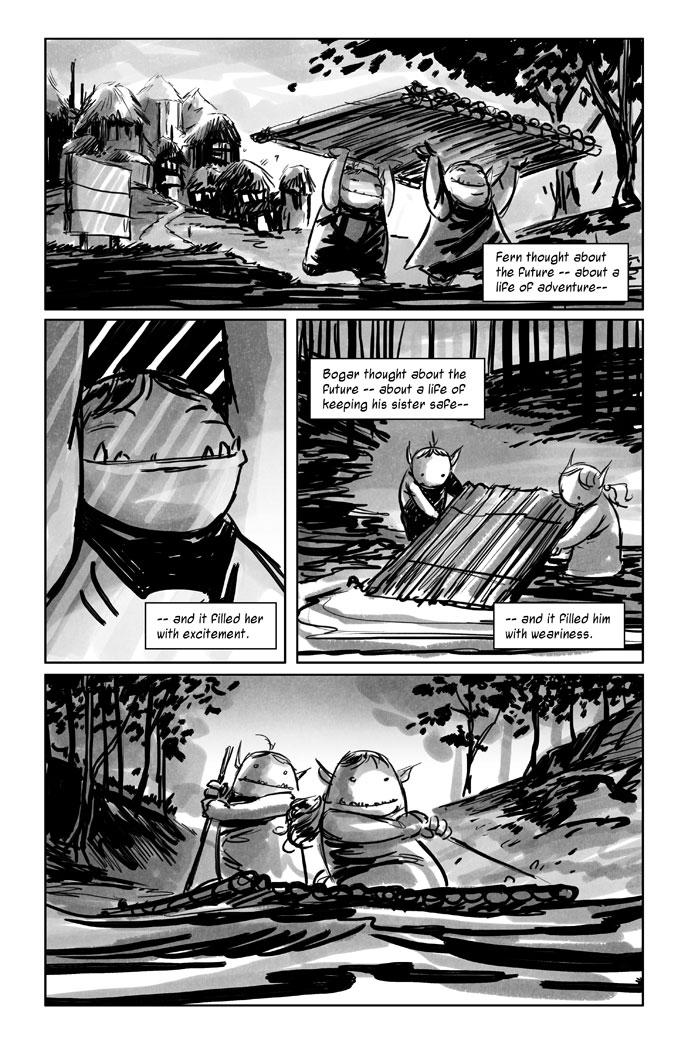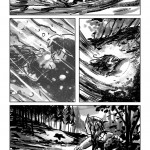With the first of Peter Jackson’s Hobbit flicks headed to theaters this holiday season, it’s time to ward ourselves against anti-orc propaganda. Do their mouthes full of tusks, their mottled gray hides or their penchant for cannibalism truly make these creatures vile? Probably. But they have moms and dads too. They have ambitions. Let’s try and be open-minded, or they’re likely to open them for us.
If you’re headed to Indiana’s Kokomo Con this weekend, you’ll be among the first readers with an opportunity to pick up Paul Allor and Thomas Boatright’s Orc Girl. Of course, the book will also be available to order from Allor’s website. We’re gonna go ahead and recommend you do so, as it’s not just a delightful coming of age tale, but the latest effort from a creator you definitely want to watch. We loved Allor’s Clockwork anthology and his recent contribution to IDW’s Teenage Mutant Ninja Turtles franchise.
We spoke to Paul about the importance of Orc Girl power:
iFanboy: I think we all have a vague picture in our head as to what an orc looks like. But that image is probably wildly different from noggin to noggin. What are your orcs like? How do they differ from, say, a troll or an ogre?
Paul Allor: This is a story that’s been in my brain for a long time. And the title — “Orc Girl” — was in my head before any of the specifics were worked out. I just liked the way it sounded: Orc Girl. Almost a rhyme, but not quite. It also sets up a nice contradiction. Orcs are brutish and violent and often not so bright. While girls… girls can be soft and tough and brilliant and sexy and shy and self-assured and deeply competent and righteously angry and bitter and irrational and beaten-down and total fucking train wrecks.
So, yeah, you’ve linked up a word with a very simple reputation, that traditionally hasn’t been treated with much depth, to a word with immense depth, with extraordinary complexity, with layers upon layers upon layers.
iF: There’s that old adage about ogres and onions…
PA: But… does any of this answer your question? What are my orcs like. My orcs are simple folk. They are quick to violence, but they can be reasoned with, unlike those nasty trolls and ogres. The Orcs have villages, they have their own sort of government, they have rules and expectations for their members.
My understanding is that orcs were a J.R.R. Tolkein invention. So it’s possible some Tolkeinologists of the World would take great umbrage to all of this, and point out the many ways I’m deeply incorrect. To which I would say, “So?!?” Then I would break into dance; Something loose-limbed and primitive. Once they were entranced by my dancing, I would break into a sprint, run far, far away, where they could never find me.
iF: If there is such a thing as a typical orcish girlhood, how does something like that go? Are there expectations for what an orc lady ought to be?
PA: Certainly. In Orkton, the Ork Village where our story takes place, all young orc girls and boys are excepted to attend school, where they learn the basics of reading, writing and arithmetic. But at a certain point, you have to learn a trade, take on an apprenticeship. Fern, our titular Orc Girl, learns to be a seamstress.
It’s a good system. Not only does everyone have a trade, but they all have a valuable trade, something that contiributes to the village in a real and tangible way. No Orcs have to worry about filling out their TPS reports, or looming redundancies. It’s a nice place to live. I wanted to write a story about people who were all basically decent, with no villains. About a small town that didn’t have any deep, dark secrets. About characters who find joy in one another, and who come to appreciate the startling beauty and breathtaking wonder of a good life, lived simply. I also wanted to write a story where the violence is minimal, and where violence against people (or orcs) isn’t seen as the first solution.
 iF: That sounds like a larger discussion of J.R.R. tokenism.
iF: That sounds like a larger discussion of J.R.R. tokenism.
PA: I’ve written some pretty evil characters, I’ve written about secrets coming to the surface, about violence and grit. And I will again. But there’s room for both.
At the same time, it does kind of feel like I’m taking a gamble. Most of these kinds of self-published one-shots tend to go fairly extreme, as a way of showing that they can do something new. They tend to be shocking or uber-violent or gritty. And again – nothing wrong with that. I enjoy those comics just as much as they next guy. But here, I’m taking a gamble that I can have the same impact with a quieter, less violent book; one that sets itself apart by going in the opposite direction than usual; by being sentimental without being cheesy; by being decent without being hokey.
But all of this is assuming the story is solid. We’ll have to wait and see what people think about that.
iF: Orc Girl has a distinctive look about it, leaning a bit toward a children’s book aesthetic thanks to Thomas Boatwright’s lovely imagery.
PA: Yeah, Thomas is so darned great. He added so, so, so much to the storytelling, in big ways and small. There’s a wedding scene in the book. We’ve hinted at the fact that this society used to be violent, and at war with humans, but no more. So during the wedding scene, what’s the Orc priest doing? He’s holding up a sword. Awesome. It tells you so much about where this guys came from; what shaped them. There are a ton of things like that; added elements, smoothed-over beats, all aimed toward making clearer, stronger storytelling.
iF: What kinds of conversations did you have about establishing this look?
I think I’d mentioned some of his earlier books that were in the same style I was looking for. For the orcs themselves, I had a very specific idea in mind. If you do a Google image search for “Orc Girl,” you’ll find a ton of cheesecake art. Women who look like Red She-Hulk, but with green skin (hey, waitaminute…). So I knew I didn’t want that. I wanted something that looked a bit cuter, but could become ferocious when need be. So I believe at one point I was getting ready to tell him all of this, but then I thought… well, he’s definitely not going to do the cheesecake thing. And Thomas is a solid enough artist and storyteller that I knew he’d do what’s best for the story. So in the end, we really didn’t discuss orc design at all; I just let him do his thing.
I think my main contribution was to say we should give one character a mohoawk, to make it easier to recognize him in later scenes.
So, yeah, Thomas totally rocked it. Amazing storytelling, and absolultely gorgeous art. But if you dug that Mohawk? All me, baby.








